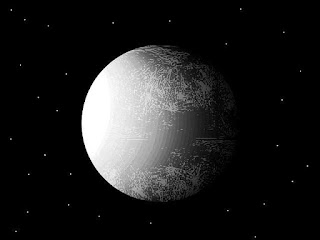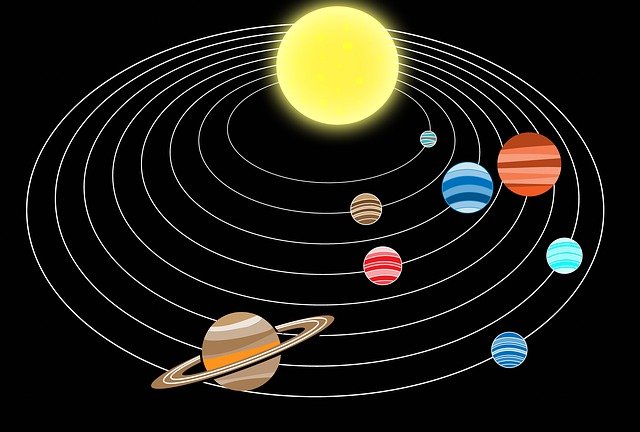8 Most Strange & Dangerous Exoplanets
NASA's Kepler space mission keeps a close eye on thousands of stars at all times, as transit methods are used to search for planets. It has searched many planets so far, its main task is to find Earth-like planets, but in search of this many very strange exoplanets have been discovered. Many of these are also very dangerous exoplanets whose environment can be said to be like hell. In addition, there are some exoplanets that were never expected to be discovered.
1. Kepler -37 b — strange exoplanet
Now let's talk about an exoplanet that is only about the size of Earth's moon. It is named Kepler -37 b. The planet was discovered by astronomers in February 2013. The planet is the smallest exoplanet ever discovered to orbit a main sequence star.
Its main star is G-type main sequence star like sun. It is called a Sub-earth by scientists. It has a distance of 15 million kilometers from its star,
which makes it seem unlikely that it will
have an atmosphere. At the same time the temperature is up to 427 degrees Celsius.
Speaking of radius and mass, it is a little more than our moon. Along with
Kepler 37b, two other exoplanets orbit the main star in this star system. At
the moment it is a present in the constellation Lyra. The G-type star of this
system is older than our sun, according to scientists; it is 5.6 billion years
old. — strange exoplant
2. Kepler -16 b —strangest exoplanet
The exoplanet was discovered on September 15, 2011 by the Kepler space mission. The transit method was used to detect this. This is a gas giant whose mass is equal to that of Saturn. It also has ice and rocks on it.
This exoplanet is part of the binary star system. Due to which this exoplanet is a circumbinary planet. Its two main stars complete each other's cycle in forty one days which are K-type and M-type category stars.
And the Kepler-16b completes their cycle in 229 days around its two stars.
It is as far from its stars as Venus is from the Sun. But the strange thing is that despite being a gas giant planet, it is close to the habitable zone. Or we can say that it is very close to the outer boundary of the habitable zone.
Its temperature also stays up to -80 degrees Celsius. This
Kepler -16 b is discovered by Laurence Doyle. — dangerous exoplanet
3. WASP - 12b —weirdest exoplanet
This is a planet called "pitch black" by scientists. Extremely close to its star, this exoplanet, also called the hot Jupiter, completes its orbit around the WASP - 12 star in 26 hours. It was discovered by superWASP planetary transit survey in April 2008 at a South African astronomical Observatory.
Due to its extremely close presence, its star is constantly ending its exoplanet's life. An in-depth study of the planet by scientists has revealed the presence of water in its atmosphere.
The Hubble Space Telescope has found that the planet has inflated like a balloon and is three times larger than Jupiter. But surprisingly, its mass is up to 40 percent larger than that of Jupiter.
It has also been confirmed by Russian astronomers
to be an exomoon. Tidally locked with its star, this WASP -12b exoplanet is 870
light-years from us. As I have already said, its star is constantly destroying
the planet, which is why scientists have estimated that it has only 10 million
years of life left. — dangerous exoplanet
4. CoRot-7b —hottest exoplanet
CoRot-7b is an exo-planet that is very close to its star and is tidally locked. Due to being tidally locked it has very strange weather. The part of the planet that faces its star always maintains a temperature of 2,600 degrees Celsius.
Due to such hot temperatures even rocks melt and turn into steam. Stones that have evaporated like water move to the other side. And the rains begin to fall. But this rain is of stones on it.
The temperature on the other side of this planet stays up to 190 degrees Celsius. CoRot-7b was discovered during the CoRoT mission. This planet is 490 light-years away from us.
It is possible that this planet may be covered with lava. It completes the
cycle of its star CoRoT-7 in just 20 hours. The weather on this planet makes it
look like hell and it falls into the category of a strange exoplanet. CoRoT-7b
exoplanet exist in the Constellation Monoceros. — strange & dangerous exoplanet
5. HD 189733 b —Intriguing exoplanet
An exoplanet named HD 189733 b orbits the star HD 189733 at a distance of about 64 light years from us. It was discovered in 2005 by the Transit method. The mass of this planet is slightly larger than that of Jupiter. It was named Deep Blue because of the colour of the exoplanet.
Stormy winds blow on this planet at a tremendous speed all the time. Strong winds that blow at a speed of 8,500 kilometres per hour contain silicate particles. Due to which there is a rain of molten glass on this planet.
Due to which this planet seems to be full of upheaval. At the same time, it is the first planet to have evidence of carbon dioxide in its atmosphere.
The planet completes its orbit
around its main star in just two days. As a result, it is clear that the planet
is not habitable at all. This planet exist in the constellation of Vulpecula. — weird exoplanet of the space
6. HD 106906-B
This exo-planet is about 300 light years away from us. Discovered on December 4, 2013, this planet is considered to be a very rare planet. In addition, it is considered to be the loneliest planet in the entire universe because it orbits its star at a distance of 738 astronomical units.
That's a very wide distance. The most distant planet recently discovered in our solar system, called Farfarout, also had a distance of 132 astronomical units from the Sun. This allows us to estimate how far it is from its star.
Because of this, it takes us more than 13,500 years for this planet to complete one orbit around its star. It is 13 times more massive than Jupiter so it is also called Super Jupiter.
The radius of this gas giant is estimated to be 840,970 km. Despite being so far away from its star, the planet's surface temperature is estimated to be up to 1,500 degrees Celsius. This exoplanet is exists in the Constellation Crux. —strangest exoplanets in the universe
7. XO-1b —scariest planets
The exoplanet was discovered in 2006 by a team led by Peter McCullough. XO-1b exoplanet's environment is extremely dangerous and hot. Hence it is also called a hot Jupiter.
The mass of this planet is almost the same as that of Jupiter. But the strange thing is that this planet is very close to its star. Gas giant planets like Jupiter are usually farther away from their star.
It was discovered by the international team of amateur astronomy with the help of the Haleakala Observatory in Hawaii. It was discovered using Transit and Radial Velocity methods.
It was discovered using Transit and Radial Velocity methods is about 500 light-years from us. This exoplanet is also called Negoiu. Studies by the Hubble Space Telescope have also found evidence of carbon dioxide, carbon monoxide, methane and water vapour in its atmosphere. It is very strange that evidence of water found on its surface.
8. Kepler -62 C —Interesting exoplanet
After talking about one Sub-earth we now know about another Sub-earth. In fact, it is an exoplanet the size of Mars. The radius of this exoplanet is only 3,440 kilometres. It was discovered by Borucki et al on 18 April 2013 during the Kepler space mission.
Its size is much smaller than that of our Earth, but its structure resembles that of Mercury. It completes the orbit of its main star Kepler-62 in 12 days. Kepler-62C, being close to its star, maintains a surface temperature of 305 degrees Celsius. Kepler-62C, being close to its star, maintains a surface temperature of 305 degrees Celsius. There are five other exoplanets in this stellar system.
The main star is a very old star that is 7 billion years old. Kepler-62C is about the same distance from its main star as Mercury. Due to which Kepler-62c receives up to 25 times more light than the Earth.











Comments
Post a Comment
Please do not enter any spam link in the comment box.